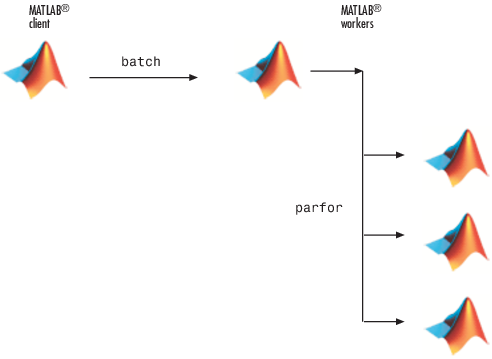Run Batch Parallel Jobs
Run a Batch Job
To offload work from your MATLAB® session to run in the
background in another session, you can use the batch command inside a script.
To create the script, type:
edit mywaveIn the MATLAB Editor, create a
for-loop:for i = 1:1024 A(i) = sin(i*2*pi/1024); end
Save the file and close the Editor.
Use the
batchcommand in the MATLAB Command Window to run your script on a separate MATLAB worker:job = batch('mywave')
The
batchcommand does not block MATLAB, so you must wait for the job to finish before you can retrieve and view its results:wait(job)
The
loadcommand transfers variables created on the worker to the client workspace, where you can view the results:load(job,'A') plot(A)When the job is complete, permanently delete its data and remove its reference from the workspace:
delete(job) clear job
batch runs your code on a local worker
or a cluster worker, but does not require a parallel pool.
You can use batch to run either scripts
or functions. For more details, see the batch reference
page.
Run a Batch Job with a Parallel Pool
You can combine the abilities to offload a job and run a loop
in a parallel pool.
This example combines the two to create a simple batch parfor-loop.
To create a script, type:
edit mywaveIn the MATLAB Editor, create a
parfor-loop:parfor i = 1:1024 A(i) = sin(i*2*pi/1024); end
Save the file and close the Editor.
Run the script in MATLAB with the
batchcommand. Indicate that the script should use a parallel pool for the loop:job = batch('mywave','Pool',3)
This command specifies that three workers (in addition to the one running the batch script) are to evaluate the loop iterations. Therefore, this example uses a total of four local workers, including the one worker running the batch script. Altogether, there are five MATLAB sessions involved, as shown in the following diagram.

To view the results:
wait(job) load(job,'A') plot(A)The results look the same as before, however, there are two important differences in execution:
The work of defining the
parfor-loop and accumulating its results are offloaded to another MATLAB session bybatch.The loop iterations are distributed from one MATLAB worker to another set of workers running simultaneously (
'Pool'andparfor), so the loop might run faster than having only one worker execute it.
When the job is complete, permanently delete its data and remove its reference from the workspace:
delete(job) clear job